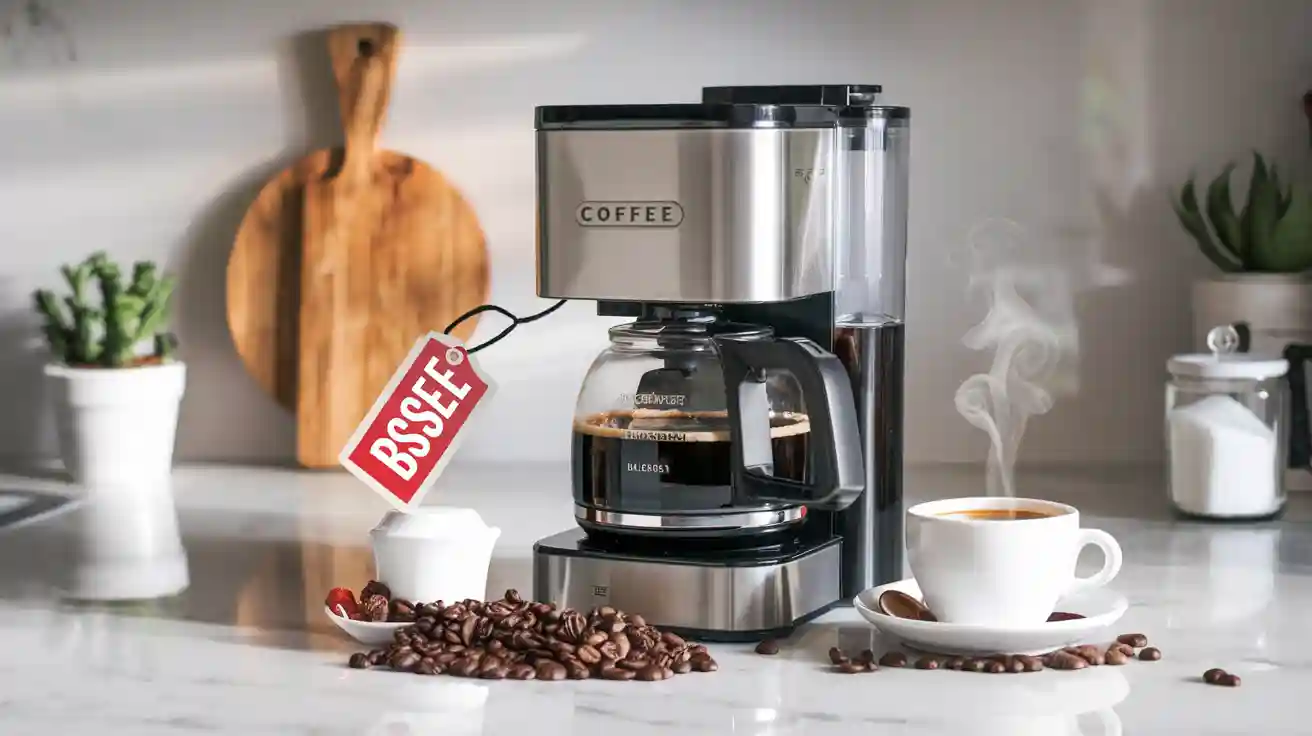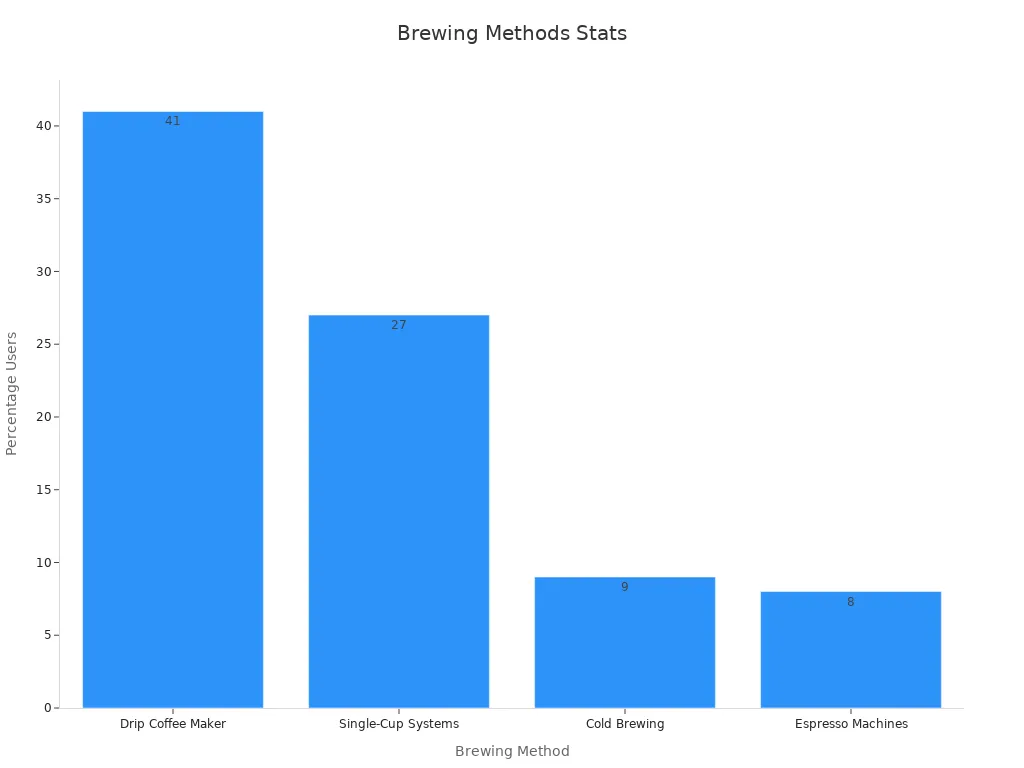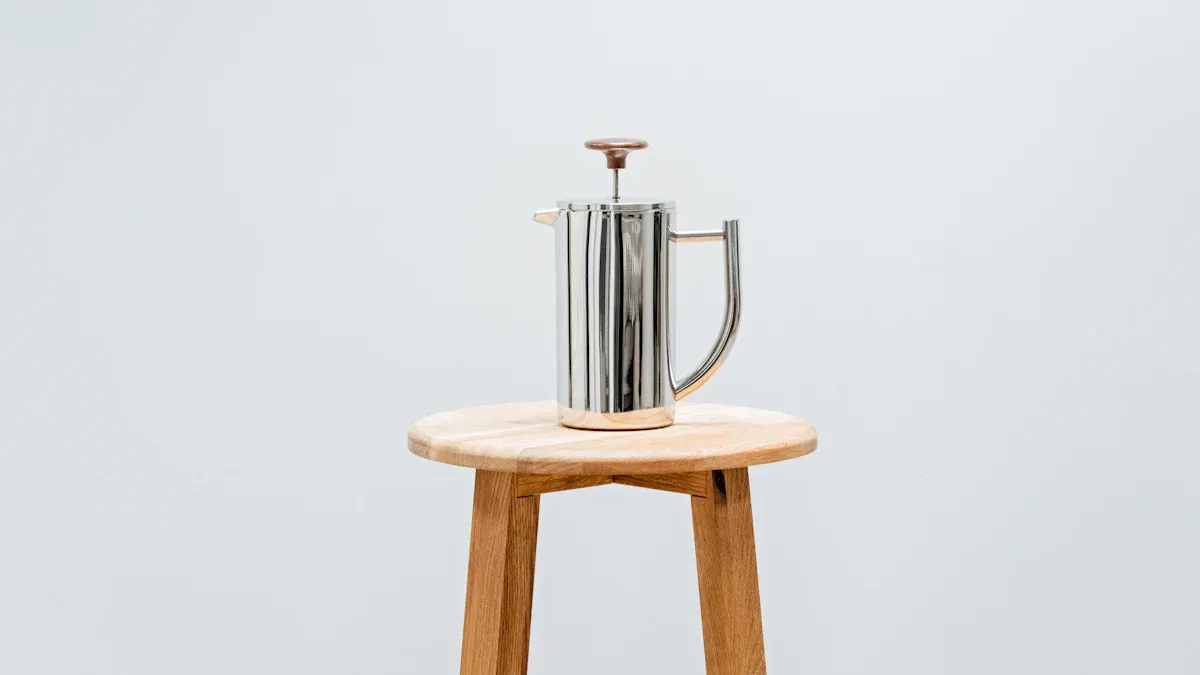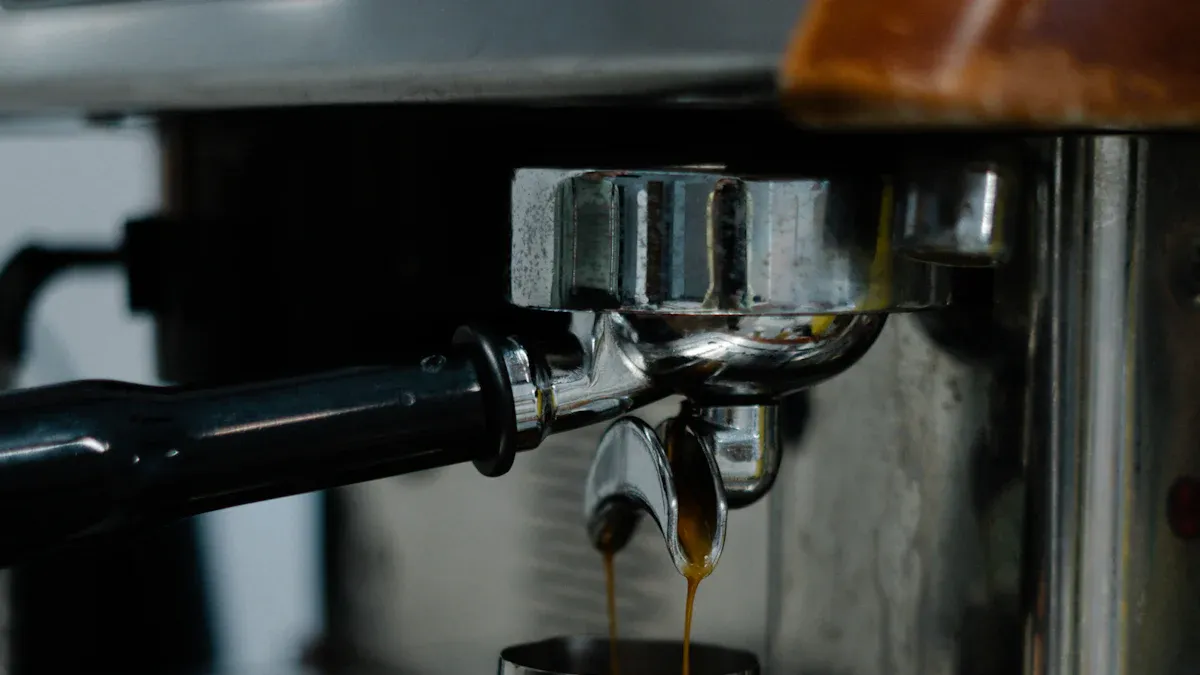
Buying a coffee maker during coffee makers on sale can feel overwhelming, but it doesn’t have to be. You want something that delivers great coffee without sacrificing quality or convenience. Start by thinking about your needs. Do you crave espresso or prefer a simple drip brew? Focusing on the right features will help you find your perfect coffee maker.
How to Buy a Coffee Maker That Matches Your Preferences
Single-Serve vs. Multi-Cup Brewing Options
When deciding between single-serve and multi-cup coffee makers, think about how much coffee you drink daily. Are you someone who enjoys just one or two cups in the morning? Or do you have a household full of coffee lovers who need their caffeine fix? Your answer will help you choose the right brewing option.
Single-serve coffee makers are perfect if you prefer convenience and minimal cleanup. They brew one cup at a time, so you can enjoy fresh coffee whenever you want. These machines are also great for experimenting with different flavors since many use pods or capsules. According to a Consumer Reports survey of over 67,000 coffee makers purchased between 2015 and 2023, single-serve machines work best for people who drink one or two mugs daily. They’re a fantastic choice if you live alone or don’t want to waste coffee.
On the other hand, multi-cup coffee makers are ideal for families or offices. These machines can brew several cups at once, making them more efficient for larger groups. Drip coffee makers, for example, often come with features like programmable timers and thermal carafes, so you can wake up to a pot of hot coffee ready to go. If you’re hosting guests or have multiple coffee drinkers in your home, a multi-cup option will save you time and effort.
Tip: If you’re unsure which to choose, consider your daily coffee habits. A single-serve machine offers flexibility, while a multi-cup brewer is better for quantity.
Choosing Between Espresso, Drip, or Specialty Coffee Makers
The type of coffee you enjoy most should guide your decision here. Do you love the bold, rich taste of espresso? Or do you prefer the simplicity of a classic drip coffee? Maybe you’re into specialty drinks like lattes or cappuccinos. Each type of coffee maker caters to different preferences.
Drip coffee makers are the most common choice for everyday coffee drinkers. They’re easy to use, reliable, and often come with helpful features like programmable settings. These machines are especially popular in North America and Europe, where convenience is key. If you want a straightforward way to make coffee for yourself or a group, drip coffee makers are a solid option.
Espresso machines, on the other hand, are all about quality and control. They’re perfect for coffee enthusiasts who enjoy customizing their drinks. With an espresso machine, you can create café-style beverages at home, from a strong shot of espresso to a creamy latte. As the specialty coffee culture grows, more people are investing in these machines to elevate their coffee experience.
Specialty coffee makers, like capsule machines, combine convenience with variety. They’re great if you like trying different flavors or need a quick cup on the go. These machines are gaining popularity in urban areas, especially as eco-friendly options become available.
| Coffee Maker Type | Key Features | Market Dynamics |
|---|---|---|
| Drip Coffee Machine | Ease of use, programmable timers, thermal carafes, better filtration | Strong demand in North America and Europe, robust home demand due to convenience |
| Capsule Coffee Machine | Speed, simplicity, flavor consistency, variety of flavors | Popular in urban areas, growing market due to eco-friendly options |
| Espresso Coffee Machine | Quality, control, customization, precision technology | Increasing demand for premium coffee at home, growth in specialty coffee culture |
Note: If you’re a beginner, start with a drip coffee maker. It’s simple and gets the job done. For a more advanced experience, consider an espresso or specialty machine.
Evaluating Coffee Maker Features for Brewing Capacity
Small vs. Large Brewing Capacities
When choosing a coffee maker, brewing capacity is one of the most important factors to consider. Do you need a machine that brews just enough for one person, or do you want something that can handle a crowd? Small and large brewing capacities each have their advantages, depending on your lifestyle and coffee habits.
Small-capacity coffee makers are perfect if you live alone or only drink one or two cups a day. These machines are compact, easy to store, and often more energy-efficient. They’re also great for ensuring your coffee stays fresh since you’re brewing just the right amount. Single-serve coffee makers, for example, are designed for small capacities and offer convenience without waste.
On the other hand, large-capacity coffee makers are ideal for families, offices, or anyone who entertains guests frequently. These machines can brew multiple cups in one go, saving you time and effort. Drip coffee makers, in particular, are popular for their ability to brew large quantities while maintaining consistent quality. Many models even come with features like thermal carafes to keep your coffee hot for hours.
Tip: If you’re unsure about the right capacity, think about how much coffee you typically drink in a day. A small-capacity machine works well for light drinkers, while a larger one is better for heavy coffee consumers or group settings.
Matching Capacity to Your Coffee Consumption Habits
Your coffee consumption habits play a big role in determining the best brewing capacity for your needs. Are you someone who enjoys a single cup in the morning, or do you need multiple cups to get through the day? Understanding your habits will help you choose a coffee maker that fits your lifestyle.
For daily coffee drinkers, a machine with a medium to large capacity is often the best choice. According to recent studies, 66% of people drink coffee daily, and 84% prefer brewing it at home. If you fall into this category, a drip coffee maker with a 10-12 cup capacity might be your best bet. These machines are reliable, easy to use, and perfect for making enough coffee to last throughout the day.
If you’re more of an occasional coffee drinker or enjoy specialty beverages like espresso, a smaller-capacity machine might be better. Single-serve systems, which account for 27% of coffee maker usage, are a great option for those who value variety and convenience. They allow you to brew one cup at a time, so you can enjoy fresh coffee without any waste.
Here’s a quick breakdown of how different brewing methods align with coffee consumption habits:
| Brewing Method | Percentage of Users |
|---|---|
| Drip Coffee Maker | 41% |
| Single-Cup Systems | 27% |
| Cold Brewing | 9% |
| Espresso Machines | 8% |

Additionally, the quality of your coffee depends on the water temperature during brewing. Research shows that the ideal range is between 91–96°C for a balanced taste and high sensory quality. Machines that operate outside this range may compromise the flavor or require longer brewing times. Here’s a quick reference:
| Water Temperature (°C) | Effect on Coffee Quality |
|---|---|
| 91–96 | High sensory quality, balanced taste, appropriate crema color |
| 88–93 | Balanced astringency and bitterness, well-balanced aroma intensity |
| Below 25 | Requires longer extraction time, may affect quality |
| Boiling (above 100) | Leads to bitter infusions, negatively impacts quality |
Note: If you’re a fan of espresso-based drinks, look for a coffee maker with precise temperature controls. This ensures your coffee tastes just right every time.
By matching the brewing capacity to your coffee habits, you’ll not only enjoy better performance but also make the most of your coffee maker. Whether you’re buying coffee makers on sale or investing in a premium model, understanding your needs will help you make the right choice.
Types of Coffee Makers to Consider

Manual vs. Automatic Coffee Makers
When choosing between manual and automatic coffee makers, it all comes down to how much control and convenience you want. Manual coffee makers give you complete control over the brewing process. You can experiment with grind sizes, water temperature, and brewing time to create a cup that matches your exact taste. These are perfect for coffee enthusiasts who enjoy the hands-on experience of crafting their brew. Plus, manual machines are often more affordable, making them a great choice if you’re on a budget.
Automatic coffee makers, on the other hand, are all about convenience. With just the press of a button, you can have a fresh cup of coffee ready in minutes. These machines are ideal for busy mornings when you don’t have time to fuss with measurements or timing. While they tend to cost more upfront, their time-saving features make them worth it for many people.
Here’s a quick comparison to help you decide:
| Feature | Manual Coffee Makers | Automatic Coffee Makers |
|---|---|---|
| Control | High control over extraction process | Limited control, automated process |
| Customization | Allows for experimentation with grind sizes | Consistent results, less customization |
| Affordability | Generally more affordable | Often more expensive due to automation |
| Convenience | Requires more effort and time | One-touch operation for quick brewing |
| Time-Saving | More time-consuming | Saves time, ideal for busy mornings |
Tip: If you love experimenting with coffee, go for a manual coffee maker. If you value speed and ease, an automatic one is your best bet.
Pod-Based vs. Ground Coffee Machines
Pod-based and ground coffee machines offer two very different brewing experiences. Pod-based coffee makers are incredibly convenient. They use pre-packaged pods, so you don’t have to measure coffee or deal with messy grounds. These machines are perfect if you want a quick, no-fuss cup of coffee. However, the cost per serving can add up over time, and the plastic pods aren’t the most eco-friendly option.
Ground coffee machines, like drip coffee makers, give you more flexibility. You can choose your favorite coffee beans, grind them to your preferred consistency, and adjust the strength of your brew. While they require a bit more effort, they’re more cost-effective in the long run. Plus, they produce less waste, making them a better choice for the environment.
Here’s how they compare:
| Aspect | Pod-Based Coffee Machines | Ground Coffee Machines |
|---|---|---|
| Cost per Serving | Up to $0.75 per pod (~$40 per pound) | $10 to $15 per pound (~$0.30 to $0.50 per cup) |
| Upfront vs. Long-Term Costs | Lower upfront cost, higher long-term costs | Higher upfront cost, lower long-term costs |
| Waste Management Costs | Over $2,500 per ton for plastic pods | Lower costs associated with traditional waste management |
| Environmental Impact | High carbon footprint due to waste | More sustainable with lower overall impact |
Note: If you’re looking for the best coffee makers for both quality and sustainability, ground coffee machines are the way to go. But if convenience is your top priority, pod-based machines are hard to beat.
Assessing Ease of Use in Coffee Makers
User-Friendly Controls and Interfaces
When it comes to coffee makers, ease of use can make or break your experience. You want a machine that’s simple to operate, especially during those groggy mornings when you need coffee fast. User-friendly controls and interfaces are key to making your coffee routine hassle-free.
Look for coffee makers with intuitive buttons or touchscreens. These features let you adjust settings like brew strength or cup size without confusion. Some models even offer remote control options, allowing you to start brewing from your phone. Imagine waking up and having your coffee ready with just a tap—sounds convenient, right?
Studies show that 90% of users rated remote control features as excellent in usability tests. For example, the Brew Master coffee maker received glowing feedback from a group of 30 users who loved its performance and ease of use. They appreciated how simple it was to start brewing and tweak settings remotely. If you value convenience, these advanced features can enhance your coffee-making experience.
Tip: If you’re new to coffee makers, start with a model that has straightforward controls. You’ll save time and avoid frustration.
Cleaning and Maintenance Requirements
Nobody enjoys cleaning a coffee maker, but it’s an essential part of keeping your machine in top shape. The easier it is to clean, the more likely you’ll stick to regular maintenance. Some coffee makers come with removable parts, like drip trays or carafes, that make cleaning a breeze. Others have self-cleaning functions that handle the dirty work for you.
Single-serve coffee makers are popular for their minimal cleanup. Nearly 70% of households choose them because they’re easy to maintain. On the other hand, drip coffee makers often require a bit more effort, especially if you’re dealing with filters and larger carafes. However, many models now include dishwasher-safe components, which simplify the process.
Note: Regular cleaning isn’t just about hygiene—it also improves performance. A clean coffee maker brews better-tasting coffee and lasts longer.
If you’re shopping for coffee makers on sale, don’t overlook maintenance requirements. A machine that’s easy to clean will save you time and keep your coffee tasting fresh. Whether you prefer single-serve or drip coffee makers, prioritize models with user-friendly cleaning features.
Durability and Build Quality in Coffee Makers

Materials That Ensure Longevity
When buying coffee makers, you want something that lasts. The materials used in a coffee maker play a huge role in its durability. Machines made with high-quality components can handle daily use without breaking down. For example, stainless steel is a popular choice for drip coffee makers because it resists rust and wear. It’s tough enough to withstand years of brewing.
Some coffee makers go even further by using advanced materials like Inconel 718. This alloy is often found in commercial coffee machines. A study showed that coffee makers with Inconel valves had 90% fewer failures over two years compared to those with stainless steel valves. These machines also maintained performance through 50,000 brewing cycles. That’s five times the average for stainless steel! If you want a coffee maker that offers both reliability and long-term performance, look for models with these premium materials.
Tip: Check the product description for details about the materials. A well-built coffee maker will save you money in the long run.
Importance of Warranty and Customer Reviews
A good warranty is like a safety net for your coffee maker. It shows that the manufacturer stands behind their product. Most coffee makers come with warranties ranging from two to five years. For instance, the Ratio Six offers a five-year warranty, which gives you peace of mind. Regular maintenance can also extend the life of your machine.
Customer reviews are another great way to gauge a coffee maker’s reliability. Look for models with high ratings and positive feedback about service quality. Here’s a quick comparison of warranty durations and insights from customer reviews:
| Coffee Maker Model | Warranty Duration | Service Quality Insight |
|---|---|---|
| Ratio Six | 5 years | Regular maintenance extends longevity |
| Most brewers | 2 years | Importance of maintenance for longevity |
Note: Before buying, read reviews to see how the coffee maker performs over time. A strong warranty and good reviews can save you from future headaches.
Additional Coffee Maker Features to Look For
Programmable Settings for Convenience
Imagine waking up to the smell of freshly brewed coffee without lifting a finger. That’s the magic of programmable settings in coffee makers. These features let you set your machine to brew at a specific time, so your coffee is ready when you need it most. Whether it’s a busy weekday morning or a lazy Sunday, a programmable coffee maker can make your routine smoother.
Many modern coffee makers also allow you to customize your brew. You can adjust the strength, temperature, and even the size of your cup. This level of personalization ensures your coffee tastes just the way you like it. Plus, with features like timers and auto shut-off, you’ll save time and energy.
| Feature | Description |
|---|---|
| Ease of Use | Most automatic coffee makers are straightforward to operate, requiring little more than adding water and coffee grounds. Many devices also feature programmable settings for added convenience. |
| Time-Saving | Many models come with features like timers and auto shut-off, which means you can set your coffee maker the night before and wake up to freshly brewed coffee. |
| Programmable Settings | Advanced models allow you to program specific brew times, strength, and even the temperature of the water, providing a truly customizable coffee experience. |
Tip: If you value convenience, look for coffee makers with programmable settings. They’re a game-changer for busy mornings.
Built-In Grinder or Frother for Versatility
A coffee maker with a built-in grinder or frother takes your coffee game to the next level. Grinders let you use fresh coffee beans, which enhances flavor and aroma. Machines like the Breville Barista Touch offer up to 30 grind settings, giving you complete control over your brew. On the other hand, models like the Jura E8 provide fewer options, but they still deliver great results.
Frothers are perfect if you love specialty drinks like lattes or cappuccinos. They create creamy, frothy milk that transforms your coffee into a café-style beverage. Whether you’re grinding beans or frothing milk, these features add versatility to your coffee maker.
- Grinders: Saeco machines let you customize grind size and temperature. Breville offers precision brewing with 30 grind settings, while Jura E8 provides six settings for simpler use.
- Frothers: Ideal for making lattes, cappuccinos, and other specialty drinks.
Note: If you enjoy experimenting with coffee, a machine with a built-in grinder or frother is worth the investment.
Energy Efficiency and Eco-Friendly Options
Energy-efficient coffee makers not only save you money but also help the environment. Look for models with energy-saving modes or auto shut-off features. These options reduce power consumption when the machine isn’t in use. Some coffee makers even use eco-friendly materials, making them a sustainable choice.
Pod-based machines often get criticized for their environmental impact. However, many brands now offer recyclable or biodegradable pods. If you prefer ground coffee, you’ll produce less waste overall. Choosing an eco-friendly coffee maker is a small step that makes a big difference.
Tip: Check for energy efficiency ratings and eco-friendly certifications when shopping for coffee makers. It’s a win-win for you and the planet.
Comparing Prices and Value When Buying Coffee Makers on Sale
Identifying Genuine Deals and Discounts
When shopping for coffee makers on sale, it’s easy to get drawn in by flashy discounts. But how can you tell if a deal is truly worth it? Start by comparing the sale price to the original price. A discount of 20% or more often signals a genuine deal, but don’t stop there. Check if the coffee maker includes all the promised features. Sometimes, lower prices mean fewer accessories or outdated models.
Another tip is to research coffee maker ratings before buying. Reviews from other buyers can reveal if the product lives up to its claims. Look for consistent praise about reliability, brewing performance, and ease of use. If a deal seems too good to be true, it might be. Always double-check the return policy in case the coffee maker doesn’t meet your expectations.
Tip: Sign up for retailer newsletters. Many stores offer exclusive discounts or early access to sales for subscribers.
Balancing Cost with Features and Quality
Finding the right coffee maker isn’t just about the price tag. It’s about getting the best value for your budget. Think about the features you actually need. For example, if you love drip coffee makers, look for models with programmable timers or thermal carafes. These extras can make your mornings easier without breaking the bank.
Quality matters too. A cheap coffee maker might save you money upfront, but it could cost more in the long run if it breaks down quickly. Stainless steel models often last longer than plastic ones. Check the warranty as well—it’s a good indicator of the manufacturer’s confidence in their product.
Finally, consider how the coffee maker fits into your daily routine. If you drink coffee every day, investing in a reliable machine makes sense. But if you’re an occasional coffee drinker, a simpler model might do the trick.
Note: Balancing cost, features, and quality ensures you get a coffee maker that meets your needs without overspending.
Buying coffee makers on sale doesn’t mean settling for less. Focus on what matters most to you—whether it’s brewing capacity, ease of use, or durability. Check ratings and reviews to gauge reliability. Compare prices and look for bundled deals. With these tips, you’ll find a coffee maker that fits your coffee needs perfectly.
FAQ
1. How do I know if a coffee maker on sale is a good deal?
Check the original price and compare features. Look for discounts over 20% and read customer reviews for reliability.
2. Can I use regular coffee grounds in a pod-based coffee maker?
Some pod machines allow reusable pods for ground coffee. Check the product details or user manual to confirm compatibility.
3. What’s the best way to clean a coffee maker?
Use a mix of water and vinegar for descaling. Wash removable parts with warm, soapy water. Follow the manufacturer’s cleaning instructions for the best results.


